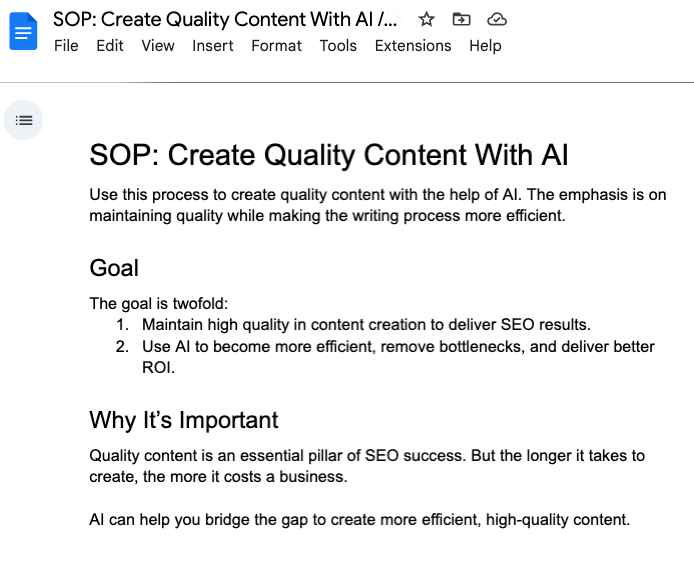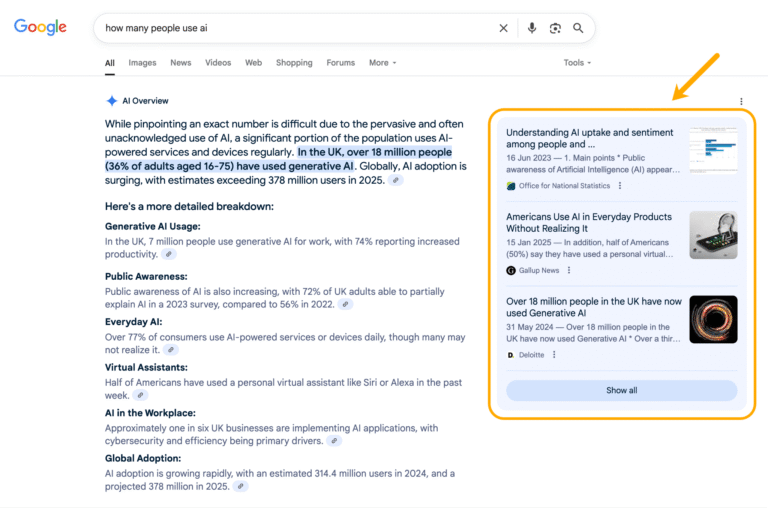According to Google, AI Overviews (AIOs) had over 1.5 billion users a month in Q1 2025. That would be 18.3% of all the people on the planet or 26.6% of all internet users. That’s a massive reach.
In traditional Ahrefs fashion, I wanted to do the largest data study ever done on AIOs to see what we could learn and share with the marketing community. For a twist on most studies, I’ve shown how they compare to search queries overall.
As a bonus, I’ll show you how you can pull the numbers yourself any time you want updated data.
Let’s dig into the data.
At the very least, AIOs aren’t likely to impact Google’s bottom line. I wonder how much they will impact companies? Companies investing in their content are also the most likely to show for AIOs. Some may even benefit from them, but the vast majority, I think, will lose traffic. We’ll have to see how it plays out.

AIOs show for 9.46% of all keywords, but they haven’t fully rolled out
At the time of writing, we have ~55.8 million AIOs from Desktop search results. This is out of 590M total keywords used to build our organic search traffic index, ~9.46% of the total. You can refer to our Big Data page at any time to get the current number of keywords in our index and the number for each country.

AIOs show for 54.61% or more of all searches by volume
You can switch the tab to Impressions to see the total search volume for all the terms showing AIOs, or their total visibility. As of writing, it’s ~98.3 billion total volume out of ~180 billion total monthly searches in our index. 54.61% of all Google searches are showing AIOs.

Sidenote.
Our data undercounts the total number of search terms and impressions for AIOs. We don’t pull SERPs for one-off or low volume queries to build our traffic index, but AIOs do show on many of these queries. We also pull AIO data from logged-out users, when they’re more likely to show to logged-in users. Many countries still don’t show them to logged-out users yet. It wouldn’t surprise me if AIOs are showing for more than 75% of all Google searches by volume.
Ahrefs and Google by the numbers
Because I don’t want anyone directly comparing our numbers to Google’s number where they say there are over 5 trillion searches annually, I feel like I need to quickly explain some differences.
Some quick math on our numbers. 180 million monthly searches * 12 months = 2.16 trillion searches a year in our data. That’s less than the 5 trillion Google says.
To try to explain the difference, there are many low-volume searches that Google classifies as anonymous queries. According to Google, 15% of searches have never been searched before. When we looked at GSC data a few years ago, 46.08% of queries were anonymous.
2.16 trillion (our yearly search numbers) / 0.54 (non-anonymous query %) = 4 trillion searches. That’s in the ballpark. Any further differences could be because anonymous queries increased, we have some gaps in our keyword database, or our volume estimates are a bit low.
Sidenote.
I do suspect the number of anonymous queries has increased and will increase further. People’s search behaviour has changed and they’re searching with much longer queries than they used to.
Google no longer has a max word count when searching. It used to be 32 words max, but now you can have as many as you want until the max URL limit is reached.

You can further filter by different data points like Intent to see more information about the type of terms where AIOs are showing.

For example, for the above search I got 24.3M keywords for Informational intent out of 24.8M total for the US. That’s 97.70% of the total.
Remember that searches can have more than 1 intent. Here’s a breakdown with the current numbers:
- Informational: 97.70%
- Navigational: 1.23%
- Commercial: 12.86%
- Transactional: 2.85%


LLMs work as next word predictors with a bit of variability built in. If you’re mentioned more in the training data such as web pages, you’re going to be mentioned more in the outputs of LLMs.
Final thoughts
Don’t wait for the next big study if you need to report what is happening with AIOs. You can run the data yourself with Ahrefs at any time with Brand Radar and Keywords Explorer.
If you have questions, message me on X or LinkedIn.
Similar Posts

Why Are .ai Domains So Expensive? The Truth Revealed
Eureka! You’ve just had a great idea for a new .ai domain name so you rush to your device or app to secure it before anyone else can. You visit your favourite domain registration company (us, I hope) do a domain search and thankfully the domain is still available. Wait a minute though, the price…
What’s New in the Drupal CMS User Guide: June 2025 Update
Since the launch of the Drupal CMS earlier this year, we’ve been hard at work documenting everything you need to build and maintain a site using this new, streamlined Drupal experience. Our goal is to make the Drupal CMS User Guide a go-to reference for site builders of all experience levels — especially those coming…

AI Content Creation: My Process for High-Quality, SEO-Friendly Articles
AI can write, but let’s be honest; it can also sound (dare I say) robotic. Without a clear process, AI-generated content can feel generic, miss SEO opportunities, or just not sound like you. The trick? Use AI as a tool, not a shortcut. This AI content creation process helps you: Get AI to generate usable content…

AI Makes Up 0.1% of Traffic, but Clicks Aren’t Everything
While AI traffic is growing as a referral source, Google still dominates by a factor of 345x, and Reddit out-refers all three major AIs combined. As it stands AI traffic isn’t making much of a dent, so is it worth pursuing? Here’s what we know so far… Sidenote. Thanks to our data scientist Xibeijia Guan for…

76% of AI Overview Citations Pull From Top 10 Pages
How much do traditional and AI search results overlap? AI models draw on search engine indexes to enrich their static training data in a process known as retrieval augmented generation (RAG), so some crossover between AI and search results is to be expected. But how much does your visibility in search align with your presence…
Drupal AI: How to Set It Up and Try It Out
After watching the Driesnote earlier this week, I wanted to try and play around with the AI tools that were demonstrated. Mostly because I find this space fascinating, and I like to try and see what kind of goofy things I can get the robots to do. So I installed all the relevant modules on…
